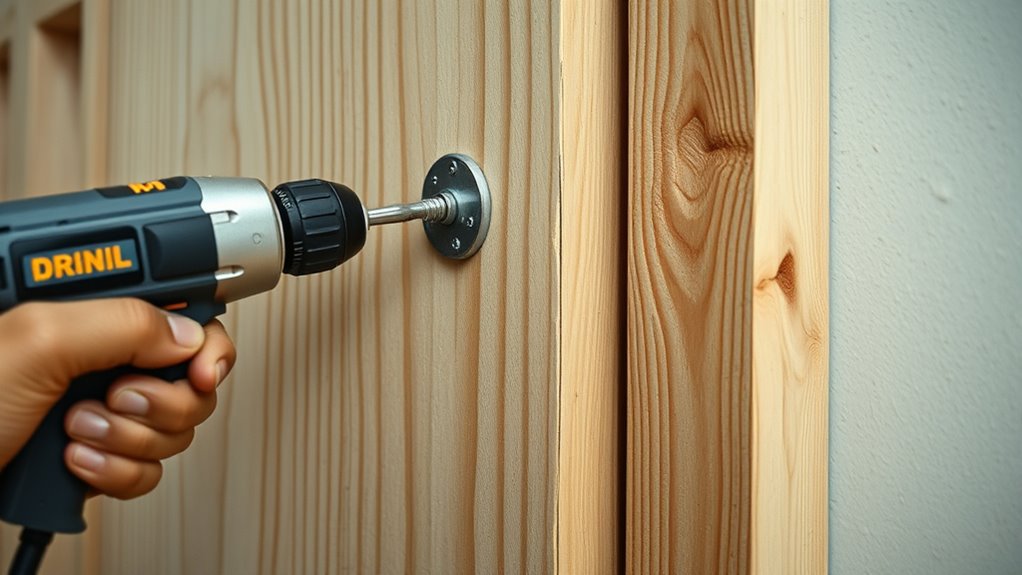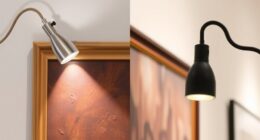When deciding between finding studs or using anchors, understand that studs offer much higher holding power, supporting heavy fixtures safely and securely. Anchors work well for lighter items or when studs aren’t accessible but may weaken over time or with added weight. The key is matching your support method to the item’s weight and wall type. To learn how to make the strongest choice for your project, keep exploring the details below.
Key Takeaways
- Studs provide higher holding power for heavy loads due to embedded framing support.
- Wall anchors are suitable for lighter items or when studs are inaccessible.
- Proper installation and anchor selection maximize holding strength regardless of wall type.
- Support methods should match item weight; use studs for over 50 lbs, anchors for lighter fixtures.
- Wall material and drywall quality influence the effectiveness of anchors versus studs for stability.
Understanding the Structural Differences Behind Walls
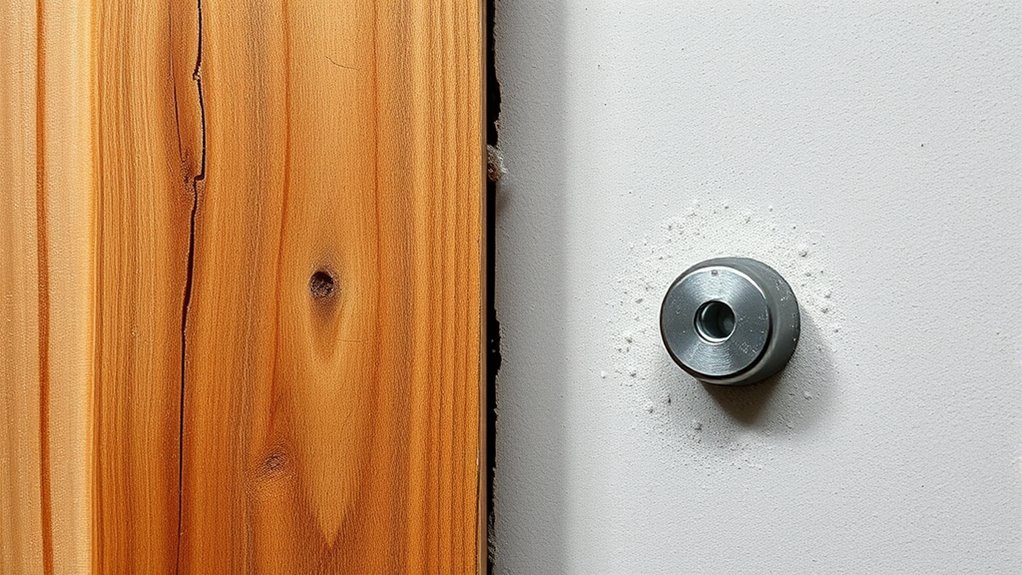
Understanding the structural differences behind walls is essential when deciding whether to find studs or use anchors. Walls are built using various framing techniques, which influence how interior finishes are attached. Studs are vertical framing members usually spaced 16 or 24 inches apart, providing solid support for heavy fixtures. In contrast, some walls are constructed with different methods, like metal framing or solid drywall, affecting the placement of support points. Recognizing these differences helps you determine the best method for securing items. When interior finishes like drywall or paneling are involved, knowing where the studs are guarantees your fixtures are stable and safe. This understanding prevents unnecessary damage and ensures your hardware holds securely, making your installation safer and more effective. Additionally, understanding the role of concrete or masonry in certain wall constructions can help you select appropriate anchors for non-standard wall types. Properly identifying wall types and their support systems is crucial for ensuring your fixtures are both secure and long-lasting.
Comparing the Strength of Studs and Wall Anchors
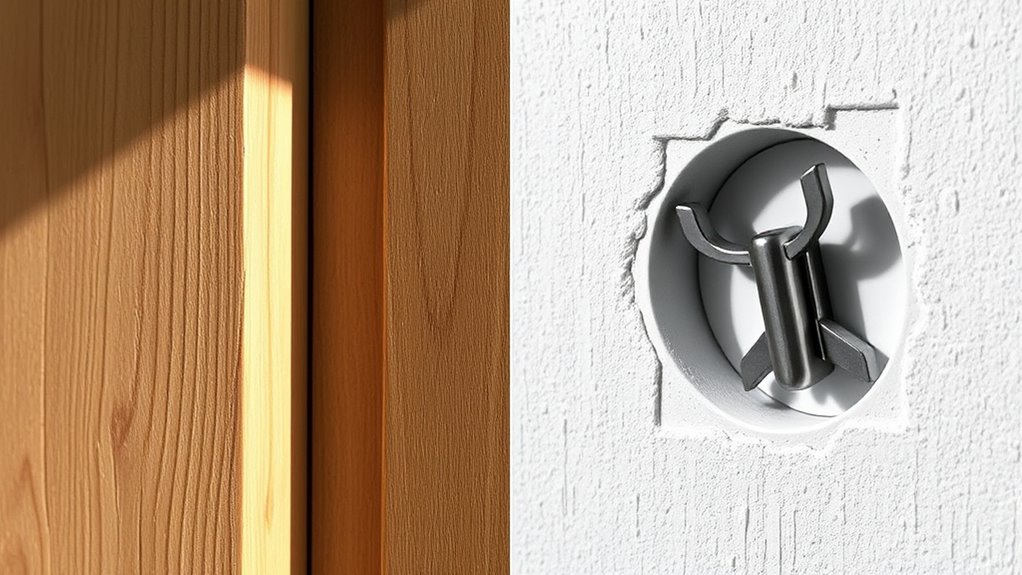
When deciding how to secure fixtures or heavy objects on your walls, it’s important to compare the strength of studs versus wall anchors. Stud durability generally surpasses that of wall anchors, especially when supporting heavy loads, making them a reliable choice for sturdy mounting. Studs offer consistent, high holding power because they’re embedded in wall framing, providing a solid anchor point. Wall anchors, on the other hand, vary in efficiency depending on their type and wall material. Some anchors are designed for lighter loads and may weaken over time or in softer drywall. For heavy objects, using studs ensures maximum strength and safety, while anchors serve well for lighter items or when studs aren’t accessible. Understanding these differences helps you choose the best securing method. Additionally, knowing the types of home security systems can help you better protect your property and ensure safety. Proper installation techniques, such as correctly locating studs, also play a crucial role in maximizing holding power and ensuring safety. Selecting the right hardware and understanding the material of your walls further enhances the reliability of your mounting. Considering the importance of proper installation, can prevent accidents and improve the longevity of your fixtures.
Factors Influencing Holding Power in Different Wall Types
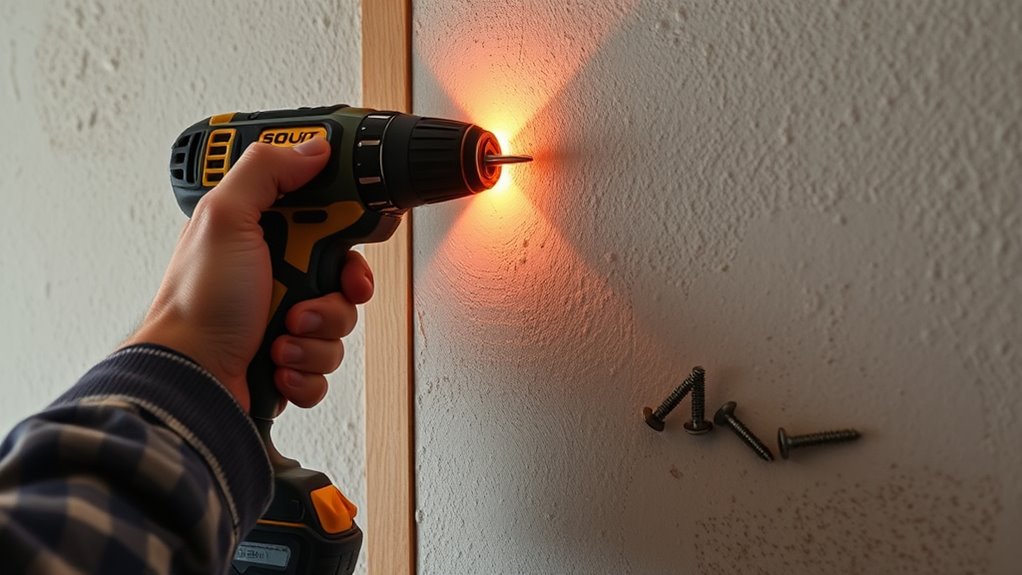
Your wall’s material strength and the type of anchor you choose directly affect how well your item stays secure. Different wall surfaces respond uniquely to various anchors, making compatibility essential. Understanding these factors helps you select the right combination for maximum holding power. Additionally, selecting the appropriate anchor type can significantly enhance the overall stability and durability of your installation. Recognizing how wall material properties influence anchoring effectiveness is crucial for achieving optimal results. For example, the porosity of the wall surface impacts how well an anchor can grip and hold under load, and choosing the correct hydrocolloid material can improve adhesion and healing when used for skin-related applications.
Wall Material Strength
The strength of your wall material directly impacts how well anchors and studs can hold your fixtures. Drywall durability varies depending on thickness and quality, affecting its load capacity. Thicker drywall generally provides better support, but lower-quality drywall may crack or crumble under stress. Moisture impact is also vital; excess moisture can weaken drywall, making it more prone to damage and reducing holding power. If your wall has high humidity or leaks, it’s essential to choose appropriate anchors or reinforce the wall structure. Understanding the specific strength of your wall material helps you determine whether studs, drywall anchors, or other fasteners are suitable for your project. Proper assessment ensures your fixtures stay secure without risking damage or failure. Additionally, moisture-resistant drywall can improve durability in damp environments, ensuring the longevity of your fixtures and maintaining holding power over time. When dealing with different wall types, considering wall material properties and the influence of material strength can help you select the most effective fasteners and anchors for your specific situation. Knowing how indoor air quality impacts your environment can also guide you in choosing safer, more reliable wall materials for health-conscious spaces.
Anchor Type Compatibility
Choosing the right anchor type depends largely on the wall material, as different anchors are designed to perform ideally in specific surfaces. When considering stud compatibility, you’ll want anchors suited for drywall, concrete, or masonry. For drywall, plastic expansion anchors are common, but toggles or molly bolts provide better holding power. In concrete or brick, you’ll need heavy-duty anchors like sleeve anchors or wedge anchors. Different anchor types have varying load capacities, so selecting the appropriate one guarantees your weight is properly supported. Using the wrong anchor type can lead to failure or damage, especially if it’s incompatible with the wall surface. Always match your anchor type to the wall material and check the manufacturer’s specifications for stud compatibility to ensure safety and stability. Proper wall anchoring techniques can significantly enhance the stability and safety of your mounted items.
When to Choose Studs Over Anchors for Heavy Items
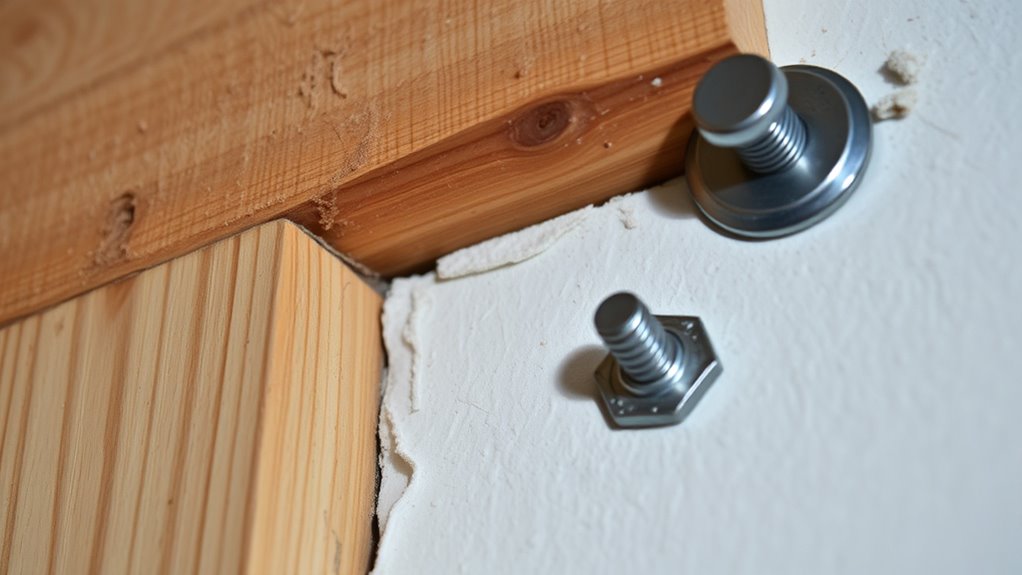
You should opt for studs when your item exceeds the weight capacity of anchors or when wall material affects stability. Knowing the weight limits and material strength helps guarantee safety and durability. Choosing studs is especially important for heavy or load-bearing objects where stability is critical. Additionally, understanding team structure and roles can guide you in selecting the appropriate method based on the type of wall and its intended use. Considering wall composition can further influence your choice, ensuring secure and lasting support. Selecting the proper installation method is essential for achieving optimal load support and safety. Being aware of load distribution can also help prevent potential failures and prolong the integrity of the installation.
Weight Capacity Limits
When hanging heavy items, understanding weight capacity limits is essential for safety and durability. Studs can typically support more weight than anchors, but factors like drywall thickness and stud spacing matter. If your drywall is thick, it can handle more weight, making studs the better choice. Additionally, closely spaced studs (16 inches apart) provide more secure support for heavy loads. Use the table below to help determine when to choose studs:
| Item Weight | Recommended Support Method |
|---|---|
| Over 50 lbs | Use studs; ensure proper drywall thickness |
| 20-50 lbs | Anchors may suffice if drywall is thick |
| Less than 20 lbs | Anchors are usually enough |
Always consider these factors to ensure your heavy items stay securely mounted. Being aware of financial management techniques can also help you make cost-effective choices when undertaking home improvement projects. Proper installation techniques are crucial to maximize support and safety when working with drywall and heavy fixtures, especially when considering structural integrity for heavy loads. For added safety, consulting building codes and guidelines can help ensure your mounting methods meet local standards.
Wall Material Considerations
Wall material plays a crucial role in determining whether studs or anchors are the better option for heavy items. Your choice depends on drywall durability and wall texture considerations. If your drywall is thick, solid, and well-installed, it can support heavier loads directly on studs. Conversely, if the drywall is thin or damaged, relying on anchors might be necessary. Wall texture also matters; rough or uneven surfaces can reduce anchor effectiveness, making studs more reliable. Consider these factors:
- Durable drywall supports heavier loads without anchors.
- Textured or uneven walls may weaken anchor hold.
- For fragile drywall or complex textures, mounting on studs provides better stability.
Understanding your wall material helps you make an informed choice, ensuring your heavy items stay secure.
Safety and Stability
Choosing studs over anchors becomes essential when safety and stability are top priorities for heavy items. During drywall installation, relying on studs guarantees your wall can support significant weight without risk of failure. Stud spacing plays a key role; standard spacing—usually 16 or 24 inches apart—provides predictable, reliable support. When hanging heavy shelves, large mirrors, or mounted TVs, attaching directly to studs guarantees a secure hold, reducing the chance of accidents or damage. Anchors may seem easier, but they often lack the holding power needed for substantial loads. By locating and utilizing studs, you ensure your installation is safer, more stable, and long-lasting, especially when stability is critical for heavy or valuable items.
Installation Tips for Maximizing Support Effectiveness
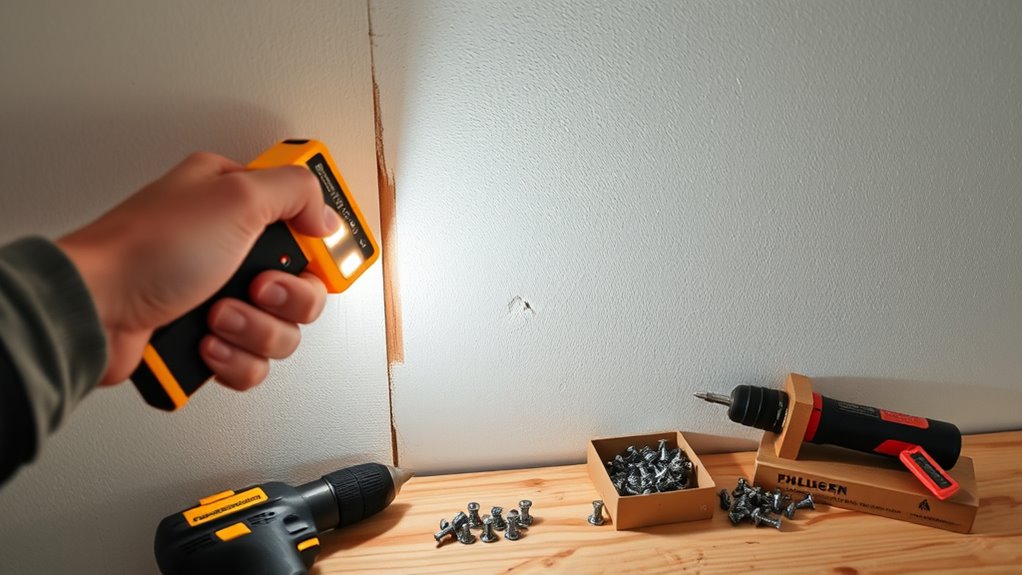
To maximize support effectiveness, it’s essential to carefully plan your installation process. Start by choosing the right anchoring tools and equipment suited for your surface and load requirements. Consider alternative installation methods if traditional options aren’t feasible, such as using toggle bolts or sleeve anchors. Proper preparation, like drilling precise holes and ensuring clean, dust-free surfaces, helps improve hold. Guarantee you follow manufacturer instructions for each product to prevent weak spots.
- Use the correct drill bits and tools for the anchors you’re installing
- Double-check measurements before drilling to avoid misalignment
- Test anchor strength with light pulls before fully loading the fixture
Common Mistakes That Reduce Holding Power
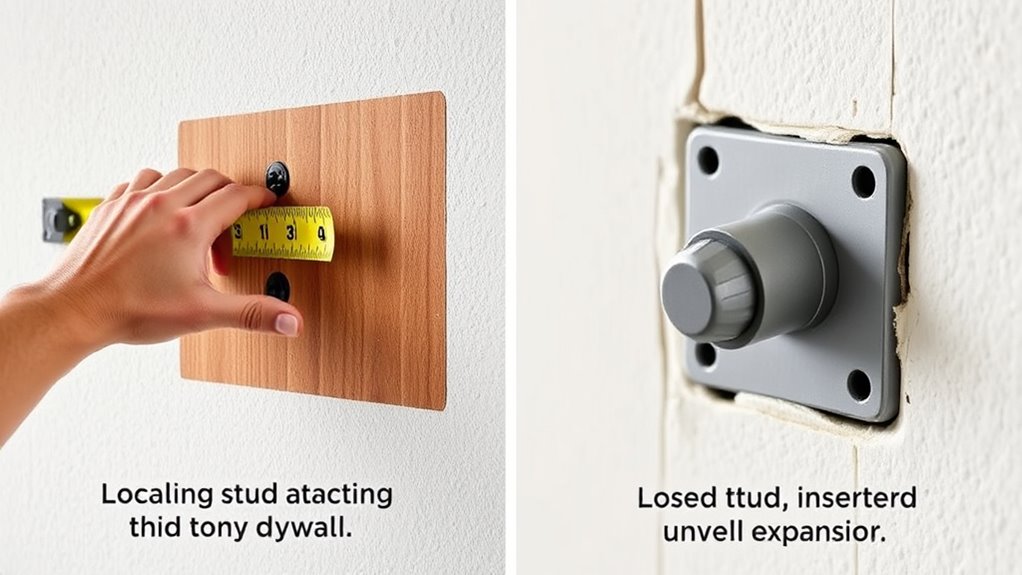
One common mistake that often weakens holding power is failing to prepare the surface properly before installation. If your drywall isn’t reinforced or smooth, anchors won’t grip securely, reducing their effectiveness. Using the wrong anchor type for your wall material also weakens holding strength. For example, plastic expansion anchors aren’t suitable for heavy loads; instead, you need toggle bolts or molly bolts. Additionally, neglecting drywall reinforcement around the anchor site can cause the wall to crumble or the anchor to pull out. Always verify the surface is clean and reinforced if needed. Selecting the appropriate anchor type for your specific wall and load requirements is essential. Proper surface preparation is key to maximizing holding power and ensuring your fixtures stay secure over time.
Frequently Asked Questions
How Do Temperature Changes Affect the Holding Power of Anchors and Studs?
Temperature changes impact the holding power of anchors and studs through thermal expansion and material contraction. When it gets hot, materials expand, potentially loosening anchors and reducing hold strength. Conversely, cold causes contraction, which can tighten connections but might also cause cracks or damage. You should contemplate these effects when installing anchors, especially in environments with significant temperature fluctuations, to ensure reliable support over time.
Are There Specific Wall Types Where Anchors Outperform Studs?
You’ll find anchors outperform studs mainly in drywall where compatibility is key, especially if the stud density is low or uneven. Anchors are designed to distribute weight evenly, making them ideal for hollow or less dense walls. In contrast, studs provide stronger support in solid walls, but in drywall with sparse or inconsistent studs, high-quality anchors can hold heavier loads more reliably.
Can Multiple Anchors or Studs Be Combined for Added Support?
Yes, you can combine multiple anchors or studs for added support. Doing so improves load distribution and provides anchor redundancy, making your setup more secure. When attaching heavy items, spreading the weight across multiple points helps prevent failure. Always guarantee the combined load stays within the maximum capacity of each anchor or stud. This approach enhances stability and reduces the risk of damage or collapse over time.
How Does Age or Wear Impact the Strength of Wall Anchors and Studs?
Age and wear can weaken wall anchors and studs through material degradation, making them less reliable over time. Corrosion, moisture, and repeated stress compromise their holding power. Proper installation techniques, like using the right anchors for your wall type and avoiding overloading, help maintain strength. Regularly inspecting for signs of damage guarantees your fixtures stay secure, preventing potential failures caused by aging or wear.
What Are the Safety Considerations When Installing Heavy Fixtures?
You should prioritize safety when installing heavy fixtures by ensuring they meet the weight capacity of your anchors or studs. Always distribute the load evenly to prevent stress points that could cause failure. Double-check that your wall anchors or studs are rated for the fixture’s weight, and use appropriate tools to secure everything tightly. Remember, overloading can compromise structural integrity, so don’t rush—safety first to avoid accidents.
Conclusion
By understanding the differences between studs and anchors, you can make smarter choices for your projects. For example, if you’re hanging a heavy bookshelf, attaching it directly to a stud provides superior support and peace of mind. Remember to follow proper installation tips and avoid common mistakes to maximize holding power. Ultimately, selecting the right method guarantees your wall hangings stay secure and safe for years to come.
